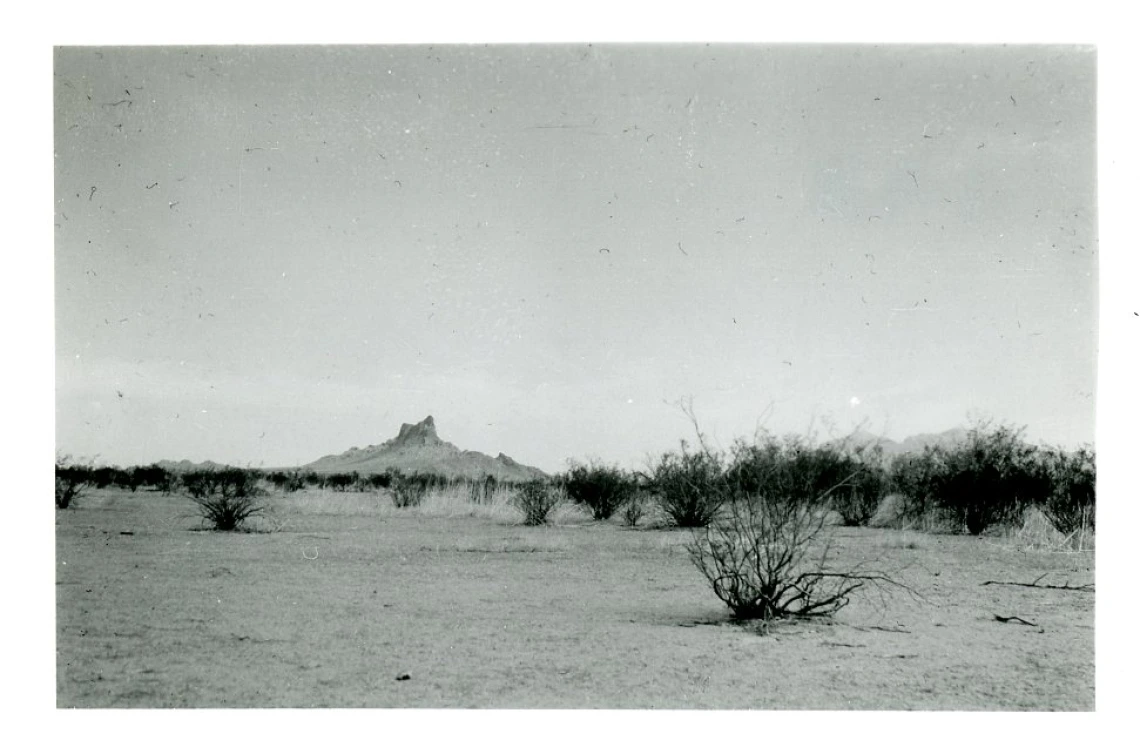Paul Howard Ezell papers

View across the desert with Picacho Peak in the distance, circa 1950 (Box 18 Folder 1).
Collection area: Arizona and Southwest
Collection dates: 1939-1987
The Papers in the first four series include Biographical Information; Ezell's Diaries and Record Books from 1939-1964, detailing events and information relevant to his activities with the United States Border Patrol, his pilot flight record and log book, his archaeological activities, and his work with the Pima-Maricopa Indian tribe; General Correspondence, chiefly between Ezell and his professional contemporaries, from 1958-1975; and Writings and Reviews written by Ezell and others, including published and unpublished manuscripts and journal articles from 1950-1987.
The fifth series, Project Files from 1951 to 1982, contains information on Organ Pipe National Monument and Painted Rock Reservoir, including material on Lower Colorado buff ware and pottery types by site locations as well as hand drawings of pottery designs, combinations, and elements; and information about a W.P.A. archaeological project in North Carolina for which Ezell served as a field supervisor in 1941.
The last series, Pima Land Claim Case Files from 1683-1974, contains extensive material on the Pima Land Claims Case for which Ezell served as an expert witness. Included are correspondence, both of a general nature and more specifically between Ezell and lawyers Z. Simpson Cox and Alfred S. Cox; transcripts of the court hearings; background materials which include information in support of Ezell's work to substantiate the land claims of the Pima-Maricopa tribe; reports containing photocopies of primary source materials which were used as exhibits in Ezell's efforts to describe a tract of land which he considered to have been used exclusively by the Pima-Maricopa Indians; and research files containing photocopies of primary source material from the Spanish, Mexican, and American periods concerning the Pima-Maricopa Indians in Arizona. These research files are followed by microfilms and audiotapes.
The bulk of the microfilm contains copies of original source materials from the Bancroft Library at the University of California, the Arizona Historical Society, the Library of Congress, the National Archives, Archivo General de la Nacion, the Escuela Nacional de Antropologia Biblioteca, the Biblioteca Nacional Archivo Franciscano, and the Archivo General y Publico. Ezell's indexes to the materials on microfilm are also included. Many of the photocopies and English translations in the research files were made from information contained on these microfilm rolls. The five reel-to-reel magnetic tapes contain Pima, Papago, Yaqui, and Mexican Indian music, an interview done by Ezell of Maricopa Indian Cyrus Sunn on 13 August 1957, and a word list given by Kisto Morago of Sacaton, Arizona, using the word list furnished by Roger Nedry in his work on the Papago. The cassette tape is primarily a discussion of the artifacts and aboriginal tribes of Australia with Norman Tindale.
The photographic materials include 14 black and white photographs, most of which were taken in 1957 at places occupied by the Pima-Maricopa Indians. Also included are twenty-seven miscellaneous negatives. The bulk of the fifty-two color slides document the burial site of Father Eusebio Kino and missions in Arizona and Sonora. The maps are primarily of southern Arizona and northern Sonora (Pimeria Alta) and contain historical and cultural information relevant to the Pima-Maricopa Indians.
Paul Howard Ezell was born 12 August 1913 on a homestead in Carbon County, Wyoming and moved west to Davis, California, with his parents around 1925. From Davis, he came to the University of Arizona, where he obtained his master's degree in archaeology in 1939 and his PhD. in 1956. His dissertation, The Hispanic Acculturation of the Gila River Pimas, was published in 1961 as Memoir no. 90 of the American Anthropological Association ( American Anthropologist, vol. 63, no. 5, part 2).
For a time, Ezell was field foreman on a W.P.A. archaeology project in North Carolina, but in 1941, he was accepted into the Immigration Border Patrol at El Paso, Texas. In 1943, he entered the Navy as a gunnery officer, returning to the Border Patrol in Ajo, Arizona, after his stint. There, he used his time to note the occurrence of archaeological sites.
In the 1950s and 1960s, Ezell worked for the Pima-Maricopa Indian tribe and served as an expert witness, testifying before the Indian Claims Commission in behalf of land claims made by the tribe against the United States government. Toward that end, he examined virtually all of the available material concerning the Pima-Maricopa Indians in the area. He also carried out archaeological surveys and conducted ethnographic and oral history field work among the Pima-Maricopa Indians.
Archaeological and historical studies of the Indians of southern Arizona, southern California, northern Sonora, and northern Baja California were Ezell's major interests during his career, along with field work in Bolivia and archaeological excavations at the Spanish presidio of San Diego.
Ezell died of cancer in his San Diego home 29 July 1988.
A collection guide explains what's in a collection. New to using our collections? Learn how to use a collection guide.
Collection guideAccess this collection
Visit us in person to access materials from this collection. Our materials are one-of-a-kind and require special care, so they can’t be checked out or taken home.
How to cite
Learn how to cite and use materials from Special Collections in your research.
